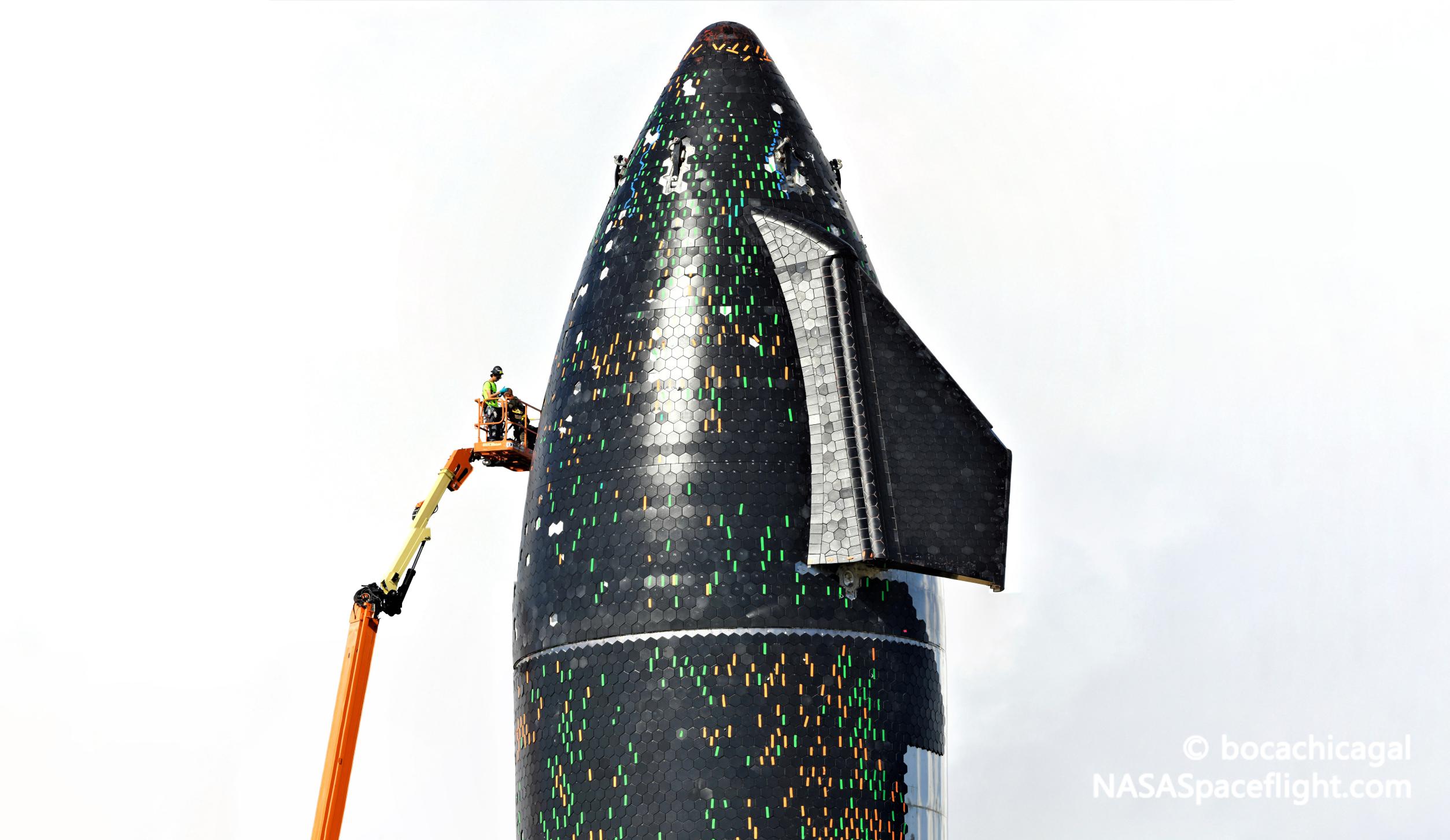
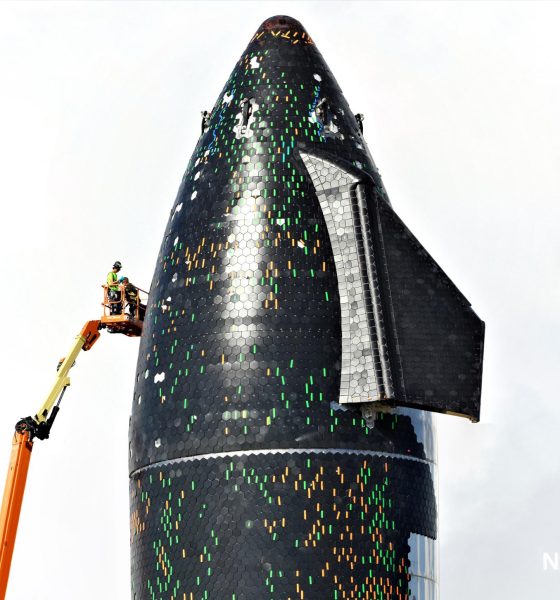
News
SpaceX repairing heat shield, reinstalling Raptors on first orbital-class Starship
SpaceX has begun reinstalling three of the six Raptor engines that will power the first orbital-class Starship and repairing the heat shield that will hopefully protect it on its first trip to space.
Known as Starship 20 or S20, the 50m (~165 ft) tall steel rocket prototype has been stationed at one of SpaceX’s two suborbital testing pads since August 13th. No testing has been done, though, and a small army of SpaceX technicians and engineers have instead spent the last three or so weeks effectively turning a collection of steel tanks, tubes, and parts into a functional rocket. While it’s unclear why SpaceX chose to do that outfitting work at an unsheltered launch pad, new activity suggests that it may be almost complete.
Exactly one month ago, SpaceX stacked Starship S20 on top of Super Heavy Booster 4 (B4) on August 6th, briefly creating the largest rocket in history and completing a fit test that was admittedly just as much a photo op. Ship 20 was rapidly destacked and returned to SpaceX’s Starbase factory, where all six of its Raptor engines were removed. About a week later, Ship 20 returned to the pad and has remained installed on Suborbital Pad B ever since.
At the time, the implication was that SpaceX had removed Ship 20’s engines to allow the prototype to complete cryogenic proof testing with hydraulic thrust simulators. However, despite having carefully modified Pad B over several weeks for that exact purpose, those modifications were rapidly removed before Ship 20’s second rollout. Precluding a proof test with thrust simulation, the next logical conclusion was that SpaceX would still perform a cryogenic proof test before reinstalling Ship 20’s Raptors and moving on to a static fire campaign.
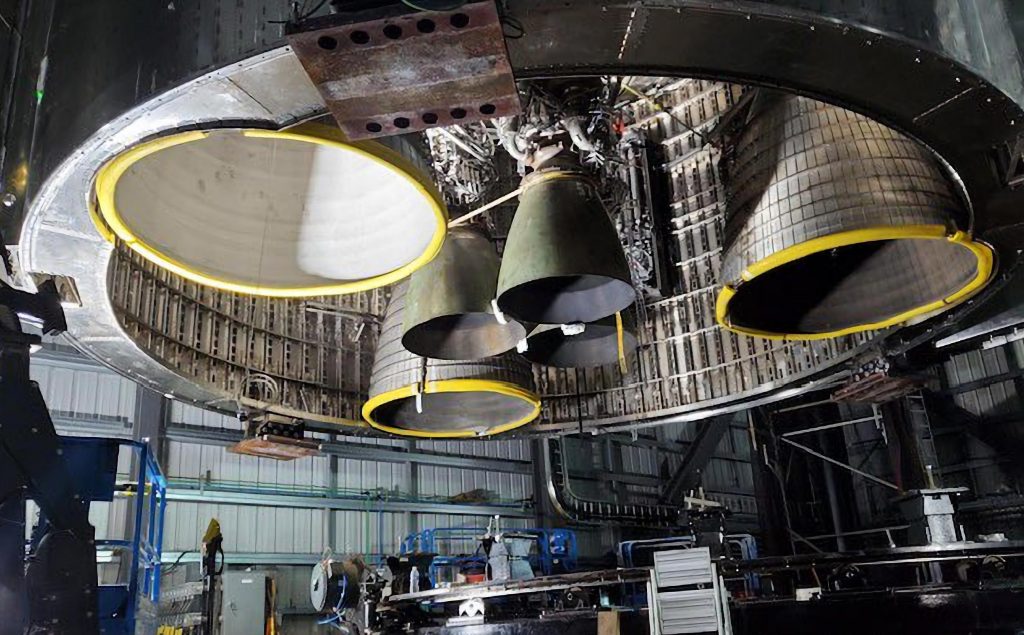
Now, even that appears to have been p1recluded. Instead, as if Ship 20 were the second or third or fourth in a series of prototypes, SpaceX rolled three center Raptors to Pad B on September 5th and began installing the engines on Starship on the 6th. It’s hard to say anything with confidence given how chaotically Starship S20’s to-be-determined qualification testing has changed in the last several weeks but, with plenty of uncertainty, Raptor installation implies that the vehicle will perform its first ambient pressure and cryogenic proof tests with engines installed.
It remains to be seen if Ship 20’s three vacuum-optimized Raptor engines will also be installed over the next few days (seemingly the logical assumption) or if SpaceX will instead complete proof tests and center Raptor static fire testing before finally moving into new territory. SpaceX has never static fired more than three Raptors at once and certainly never tested multiple Raptor Vacuum (RVac) engines in close proximity – let alone all six simultaneously.
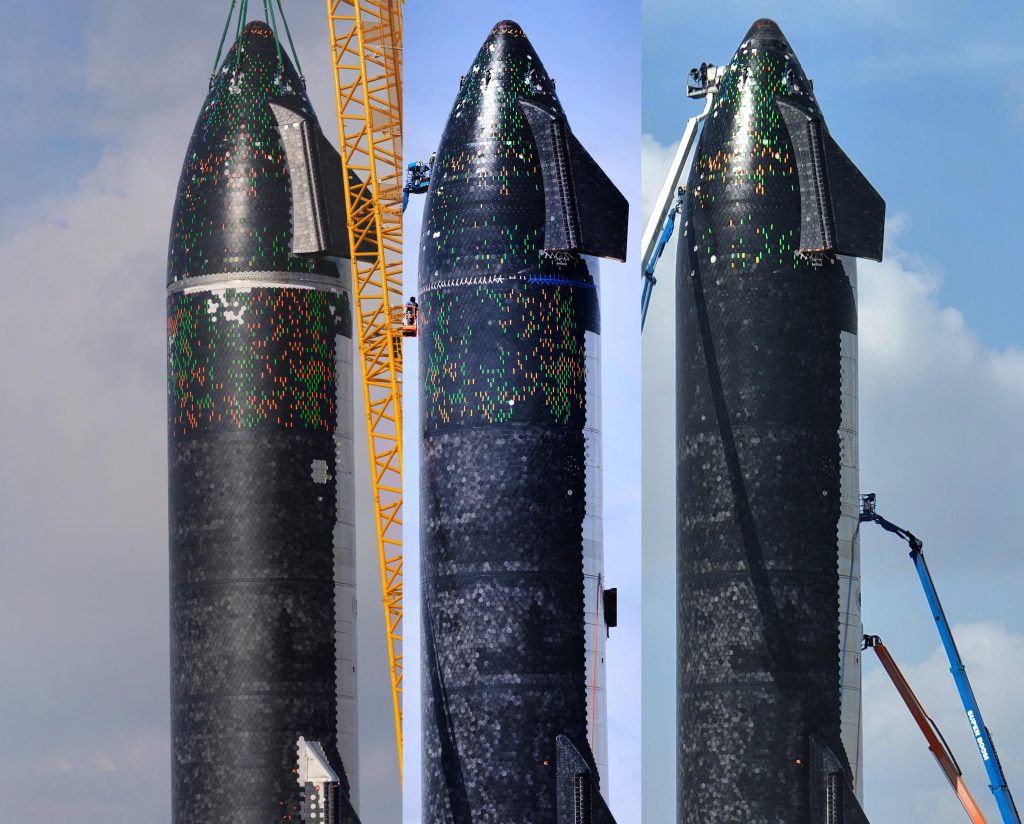
Meanwhile, much of the focus of the last few weeks appears to have been on finishing Ship 20 plumbing and avionics wire runs, though it’s hard to say exactly what has been done. What is extremely visible and easy to follow, though, is the process of finishing the first orbital-class Starship heat shield and repairing a few hundred tiles broken during its pathfinder installation. SpaceX has installed 500-1000+ tiles on flown Starship prototypes like SN15 but the company has never come close to the ~15,000 needed to cover the entire windward side of the world’s largest rocket upper stage.
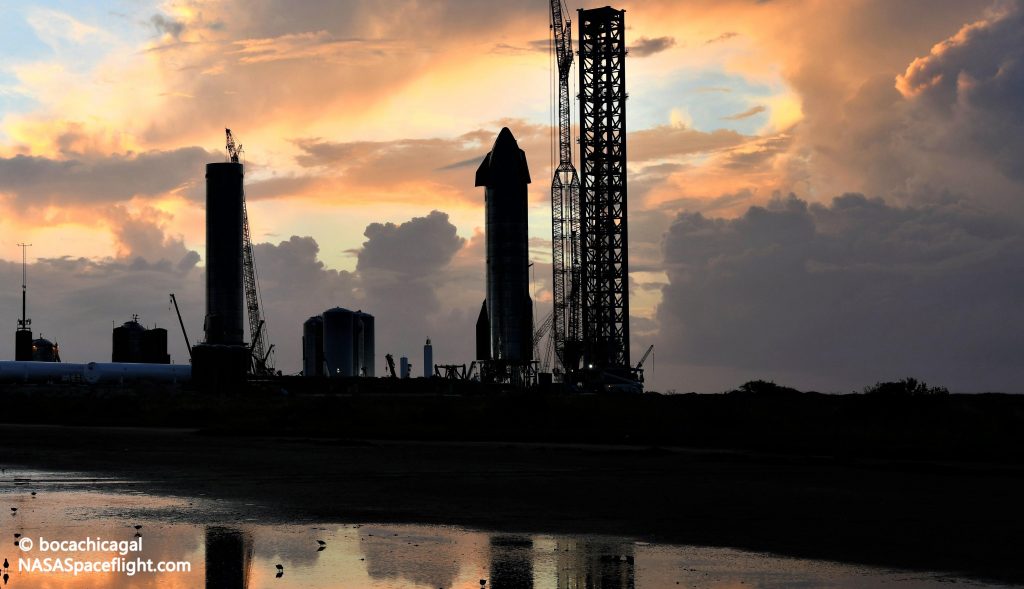

SpaceX has undertaken that process for the first time over the last six or so weeks and unsurprisingly seen a number of successes and failures. At some point along the way, a significant fraction of the ceramic, dinner-plate-sized tiles SpaceX technicians installed chipped, broke, shattered, or ran into other fitment issues. Over the last month or so, a great deal of progress has been made fixing those problem tiles and SpaceX has also more or less completed tile installation on the angular ‘aerocovers’ that protect Starship’s flap mechanisms – requiring dozens of custom tiles with complex shapes and curves.
As of September 6th, Starship S20’s heat shield appears to be around 95% complete and the installation of Raptor engines implies that the rocket’s plumbing, avionics, and tankage are also nearly finished. In other words, after many weeks of work, SpaceX’s first orbital-class Starship prototype could be ready to kick off cryoproof and static fire testing just a week or so (and maybe less) from now. Stay tuned for updates!

Elon Musk
Elon Musk’s X will start using a Tesla-like software update strategy
The initiative seems designed to accelerate updates to the social media platform, while maintaining maximum transparency.

Elon Musk’s social media platform X will adopt a Tesla-esque approach to software updates for its algorithm.
The initiative seems designed to accelerate updates to the social media platform, while maintaining maximum transparency.
X’s updates to its updates
As per Musk in a post on X, the social media company will be making a new algorithm to determine what organic and advertising posts are recommended to users. These updates would then be repeated every four weeks.
“We will make the new 𝕏 algorithm, including all code used to determine what organic and advertising posts are recommended to users, open source in 7 days. This will be repeated every 4 weeks, with comprehensive developer notes, to help you understand what changed,” Musk wrote in his post.
The initiative somewhat mirrors Tesla’s over-the-air update model, where vehicle software is regularly refined and pushed to users with detailed release notes. This should allow users to better understand the details of X’s every update and foster a healthy feedback loop for the social media platform.
xAI and X
X, formerly Twitter, has been acquired by Elon Musk’s artificial intelligence startup, xAI last year. Since then, xAI has seen a rapid rise in valuation. Following the company’s the company’s upsized $20 billion Series E funding round, estimates now suggest that xAI is worth tens about $230 to $235 billion. That’s several times larger than Tesla when Elon Musk received his controversial 2018 CEO Performance Award.
As per xAI, the Series E funding round attracted a diverse group of investors, including Valor Equity Partners, Stepstone Group, Fidelity Management & Research Company, Qatar Investment Authority, MGX, and Baron Capital Group, among others. Strategic partners NVIDIA and Cisco Investments also continued support for building the world’s largest GPU clusters.
News
Tesla FSD Supervised wins MotorTrend’s Best Driver Assistance Award
The decision marks a notable reversal for the publication from prior years, with judges citing major real-world improvements that pushed Tesla’s latest FSD software ahead of every competing ADAS system.

Tesla’s Full Self-Driving (Supervised) system has been named the best driver-assistance technology on the market, earning top honors at the 2026 MotorTrend Best Tech Awards.
The decision marks a notable reversal for the publication from prior years, with judges citing major real-world improvements that pushed Tesla’s latest FSD software ahead of every competing ADAS system. And it wasn’t even close.
MotorTrend reverses course
MotorTrend awarded Tesla FSD (Supervised) its 2026 Best Tech Driver Assistance title after extensive testing of the latest v14 software. The publication acknowledged that it had previously criticized earlier versions of FSD for erratic behavior and near-miss incidents, ultimately favoring rivals such as GM’s Super Cruise in earlier evaluations.
According to MotorTrend, the newest iteration of FSD resolved many of those shortcomings. Testers said v14 showed far smoother behavior in complex urban scenarios, including unprotected left turns, traffic circles, emergency vehicles, and dense city streets. While the system still requires constant driver supervision, judges concluded that no other advanced driver-assistance system currently matches its breadth of capability.
Unlike rival systems that rely on combinations of cameras, radar, lidar, and mapped highways, Tesla’s FSD operates using a camera-only approach and is capable of driving on city streets, rural roads, and freeways. MotorTrend stated that pure utility, the ability to handle nearly all road types, ultimately separated FSD from competitors like Ford BlueCruise, GM Super Cruise, and BMW’s Highway Assistant.
High cost and high capability
MotorTrend also addressed FSD’s pricing, which remains significantly higher than rival systems. Tesla currently charges $8,000 for a one-time purchase or $99 per month for a subscription, compared with far lower upfront and subscription costs from other automakers. The publication noted that the premium is justified given FSD’s unmatched scope and continuous software evolution.
Safety remained a central focus of the evaluation. While testers reported collision-free operation over thousands of miles, they noted ongoing concerns around FSD’s configurable driving modes, including options that allow aggressive driving and speeds beyond posted limits. MotorTrend emphasized that, like all Level 2 systems, FSD still depends on a fully attentive human driver at all times.
Despite those caveats, the publication concluded that Tesla’s rapid software progress fundamentally reshaped the competitive landscape. For drivers seeking the most capable hands-on driver-assistance system available today, MotorTrend concluded Tesla FSD (Supervised) now stands alone at the top.
News
Elon Musk’s Grokipedia surges to 5.6M articles, almost 79% of English Wikipedia
The explosive growth marks a major milestone for the AI-powered online encyclopedia, which was launched by Elon Musk’s xAI just months ago.

Elon Musk’s Grokipedia has grown to an impressive 5,615,201 articles as of today, closing in on 79% of the English Wikipedia’s current total of 7,119,376 articles.
The explosive growth marks a major milestone for the AI-powered online encyclopedia, which was launched by Elon Musk’s xAI just months ago. Needless to say, it would only be a matter of time before Grokipedia exceeds English Wikipedia in sheer volume.
Grokipedia’s rapid growth
xAI’s vision for Grokipedia emphasizes neutrality, while Grok’s reasoning capabilities allow for fast drafting and fact-checking. When Elon Musk announced the initiative in late September 2025, he noted that Grokipedia would be an improvement to Wikipedia because it would be designed to avoid bias.
At the time, Musk noted that Grokipedia “is a necessary step towards the xAI goal of understanding the Universe.”
Grokipedia was launched in late October, and while xAI was careful to list it only as Version 0.1 at the time, the online encyclopedia immediately earned praise. Wikipedia co-founder Larry Sanger highlighted the project’s innovative approach, noting how it leverages AI to fill knowledge gaps and enable rapid updates. Netizens also observed how Grokipedia tends to present articles in a more objective manner compared to Wikipedia, which is edited by humans.
Elon Musk’s ambitious plans
With 5,615,201 total articles, Grokipedia has now grown to almost 79% of English Wikipedia’s article base. This is incredibly quick, though Grokipedia remains text-only for now. xAI, for its part, has now updated the online encyclopedia’s iteration to v0.2.
Elon Musk has shared bold ideas for Grokipedia, including sending a record of the entire knowledge base to space as part of xAI’s mission to preserve and expand human understanding. At some point, Musk stated that Grokipedia will be renamed to Encyclopedia Galactica, and it will be sent to the cosmos.
“When Grokipedia is good enough (long way to go), we will change the name to Encyclopedia Galactica. It will be an open source distillation of all knowledge, including audio, images and video. Join xAI to help build the sci-fi version of the Library of Alexandria!” Musk wrote, adding in a later post that “Copies will be etched in stone and sent to the Moon, Mars and beyond. This time, it will not be lost.”








